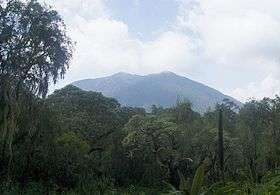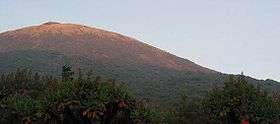Karisoke Research Center
The Karisoke Research Center in Rwanda's Volcanoes National Park was founded by Dian Fossey on 24 September 1967, to study endangered mountain gorillas. Fossey located the campCoordinates: 1°28′25″S 29°29′07″E / 1.4736°S 29.4854°E in Rwanda's Virunga volcanic mountain range, between Mount Karisimbi and Mount Bisoke, and named it by combining the names of the two mountains.
The camp continued to function even after Fossey's murder in December 1985, under the auspices of the Dian Fossey Gorilla Fund International.[1] In 2012, Karisoke moved its headquarters to a more modern facility in Musanze.
At the time Fossey founded Karisoke, she feared that the mountain gorilla might become extinct by the end of the 20th century, as her mentor, Dr. Louis Leakey, had warned. A census published in 1981 found that the population had fallen to 242 individuals, from a 1960 estimate of 400-500.[2] Now, 45 years later, some 480 mountain gorillas are known to inhabit the Virunga mountains (according to a 2010 census), a significant increase. Karisoke survived Fossey's murder in 1985 as well as years of civil strife, and also expanded tremendously over the past few decades.[3]
History
Rwandan Genocide
The site was closed down during the genocide and civil war in Rwanda when most of the workers became refugees in neighboring Democratic Republic of Congo (formerly known as Zaire). Most Karisoke trackers lost their homes and possessions in the war and some saw family members murdered. Some were imprisoned when they returned home. Yet dedicated Rwandan staff continued to monitor the gorillas during this period, whenever possible.
By 1998 Karisoke’s expatriate staff had evacuated five times. The facility was destroyed three times, rebuilt twice, and eventually relocated to Musanze (formerly Ruhengeri). Despite the constant threat of war, Karisoke continued to upgrade its capacity for scientific research through new technology and new partnerships with local authorities and other conservation organizations. Somehow, the gorillas survived the war years in good condition, despite the greatly increased number of snares set by poachers.[4] The buildings, now in ruins and overgrown by vegetation, are still a monument to Fossey, her work and the first camp dedicated exclusively to the study of mountain gorillas. The Dian Fossey Gorilla Fund continues to operate the Karisoke Research Center, from its Regional Research Center headquarters in Musanze.
Current
The Karisoke Research Center is currently the world’s best hope for the survival of endangered mountain gorillas and their ecologically critical habitat. Thanks to its active conservation program, the mountain gorillas of the Virungas are the only great ape species to have increased in number in recent decades.[5]
Karisoke today conducts extensive daily protection and monitoring of the mountain gorillas; numerous science and research projects; various education initiatives; and community health and development projects. Since its establishment in 1967, Karisoke has produced an unparalleled amount of information about the mountain gorillas and their habitat and attracts scientists and science students from around the world.
Karisoke is also a significant resource for the people who live near the gorillas, currently employing more than 100 staff members, the great majority of whom are Rwandan. Over half of these are involved in research, protection and monitoring of the gorillas. Others are engaged in biodiversity and socioeconomic research, education, health, and administration.[6] In addition, Karisoke provides the human communities in the area with education, health and economic development programs. Staff members provide conservation education to primary and secondary school students and to adult community members through a variety of media. The Fossey Fund supports and has helped renovate schools and a health clinic near the park and supports clean water and parasite treatment and prevention programs that reduce transmission of disease from people to gorillas as well as improving the quality of life for the communities.
References
- ↑ The Dianne Fossey Gorilla Fund International. Accessed September 13, 2016.
- ↑ "40 Years at Karisoke, 1967-2007, A Remarkable History". Gorilla Journal (Fall): 1. 2007.
- ↑ "Fossey Legacy, New Horizons: The Dian Fossey Gorilla Fund International Annual Report 2011". Gorilla Journal: 2. Summer 2012.
- ↑ "40 Years at Karisoke, 1967-2007, A Remarkable History". Gorilla Journal (Fall): 1–2. 2007.
- ↑ "Fossey Legacy, New Horizons: The Dian Fossey Gorilla Fund International Annual Report 2011". Gorilla Journal: 2. Summer 2012.
- ↑ "Fossey Legacy, New Horizons: The Dian Fossey Gorilla Fund International Annual Report 2011". Gorilla Journal: 2. Summer 2012.
Bibliography
- Martha M. Robbins; Pascale Sicotte; Kelly J. Stewart (2001). Mountain Gorillas: Three Decades of Research at Karisoke. Cambridge University Press. ISBN 0-521-78004-7.

